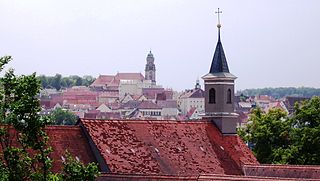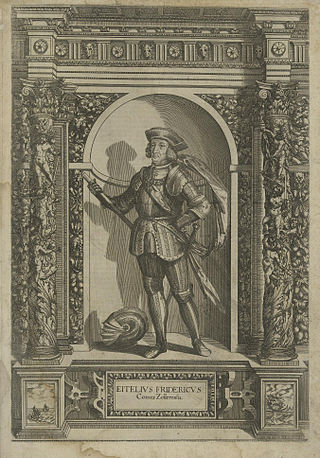
The House of Hohenzollern is a formerly royal German dynasty whose members were variously princes, electors, kings and emperors of Hohenzollern, Brandenburg, Prussia, the German Empire, and Romania. The family came from the area around the town of Hechingen in Swabia during the late 11th century and took their name from Hohenzollern Castle. The first ancestors of the Hohenzollerns were mentioned in 1061.

Hohenzollern-Sigmaringen was a principality in southwestern Germany. Its rulers belonged to the senior Swabian branch of the House of Hohenzollern. The Swabian Hohenzollerns were elevated to princes in 1623. The small sovereign state with the capital city of Sigmaringen was annexed to the Kingdom of Prussia in 1850 following the abdication of its sovereign in the wake of the revolutions of 1848, then became part of the newly created Province of Hohenzollern.

Sigmaringen is a town in southern Germany, in the state of Baden-Württemberg. Situated on the upper Danube, it is the capital of the Sigmaringen district.
Sigmaringen is a Landkreis (district) in the south of Baden-Württemberg, Germany. Neighboring districts are Reutlingen, Biberach, Ravensburg, Bodensee, Constance, Tuttlingen, and Zollernalbkreis.

The Province of Hohenzollern was a district of Prussia from 1850 to 1946. It was located in Swabia, the region of southern Germany that was the ancestral home of the House of Hohenzollern, to which the kings of Prussia belonged.

Hechingen is a town in central Baden-Württemberg, Germany. It is situated about 60 kilometres (37 mi) south of the state capital of Stuttgart and 90 kilometres (56 mi) north of Lake Constance and the Swiss border.

Horb am Neckar is a town in the southwest of the German state of Baden-Württemberg. It is located on the Neckar river, between Offenburg to the west and Tübingen to the east. It has around 25,000 inhabitants, of whom about 6,000 live in the main town of Horb, and the remainder in 18 associated villages and districts which form part of the same municipality. If the entire municipality is counted, it is the largest town in the District of Freudenstadt.

Nusplingen is a municipality of the Zollernalb district of Baden-Württemberg, Germany.

Sigmaringen Castle was the princely castle and seat of government for the Princes of Hohenzollern-Sigmaringen. Situated in the Swabian Alb region of Baden-Württemberg, Germany, this castle dominates the skyline of the town of Sigmaringen. The castle was rebuilt following a fire in 1893, and only the towers of the earlier medieval fortress remain. Schloss Sigmaringen was a family estate of the Swabian Hohenzollern family, a cadet branch of the Hohenzollern family, from which the German Emperors and kings of Prussia came. During the closing months of World War II, Schloss Sigmaringen was briefly the seat of the Vichy French Government after France was liberated by the Allies. The castle and museums may be visited throughout the year, but only on guided tours. It is still owned by the Hohenzollern-Sigmaringen family, although they no longer reside there.

Bisingen is a municipality in the Zollernalbkreis district of Baden-Württemberg, Germany.

Dautmergen is a municipality in the Zollernalbkreis district of Baden-Württemberg, Germany.

Grosselfingen is a town in the Zollernalbkreis district, in Baden-Württemberg, Germany.
Karl I of Hohenzollern was Count of Hohenzollern from 1525 to 1575. He was Imperial Archchamberlain and chairman of the Aulic Council.

Count Eitel Friedrich IV of Hohenzollern was the founder and first Count of the line Hohenzollern-Hechingen as Eitel Friedrich I.
Friedrich V of Zollern nicknamed, the Illustrious was a Count of Zollern.

Count Christoph of Hohenzollern-Haigerloch was the first Count of Hohenzollern-Haigerloch.
Albrecht II of Hohenberg-Rotenburg was Count of Hohenberg and Haigerloch and imperial governor of Lower Swabia. He was a member of the house of Zollern-Hohenberg, a branch of the Swabian House of Hohenzollern which split off in the 12th century. Two stanzas in the Codex Manesse are attributed to him under the name of Albrecht von Haigerloch.

The Hohenzollerische Landesbahn (HzL) was the largest non-federally owned railway company in the German state of Baden-Württemberg after the Albtal-Verkehrs-Gesellschaft and Südwestdeutsche Verkehrs-Aktiengesellschaft. It operated passenger and freight traffic since 1900. Its field of activity latterly extended to large parts of southern Baden-Württemberg.

The Eyach–Hechingen railway is a branch line in Baden-Württemberg, Germany. It is owned by the Hohenzollerische Landesbahn (HzL). It runs from Eyach via Haigerloch to Hechingen. It is single track throughout and is not electrified.























